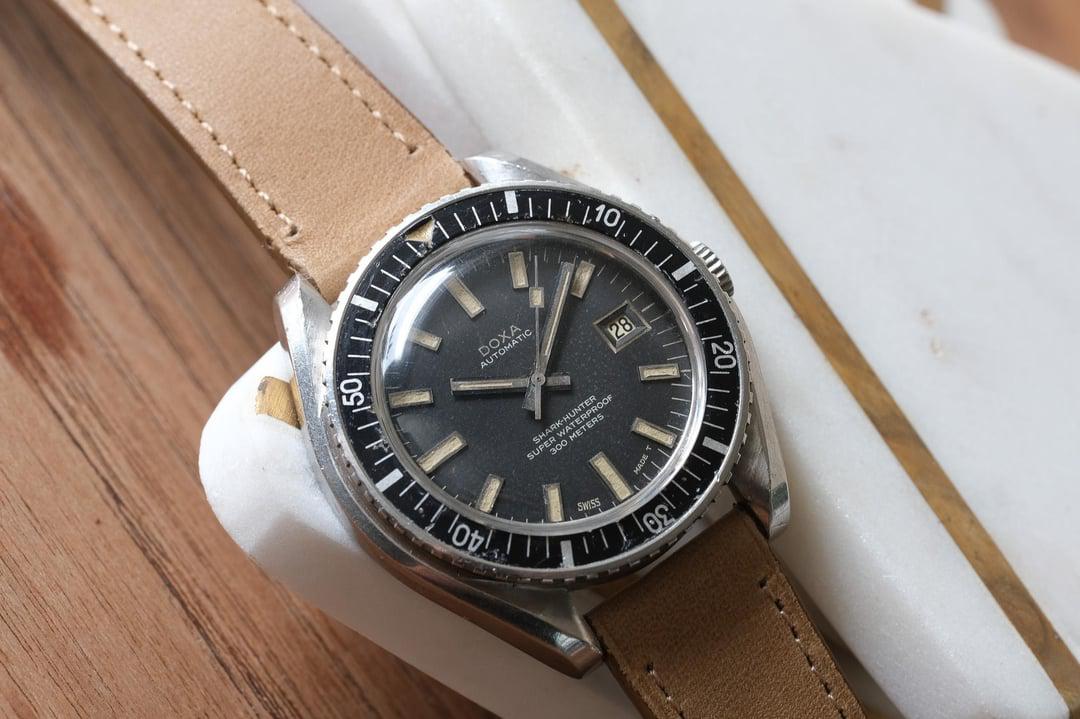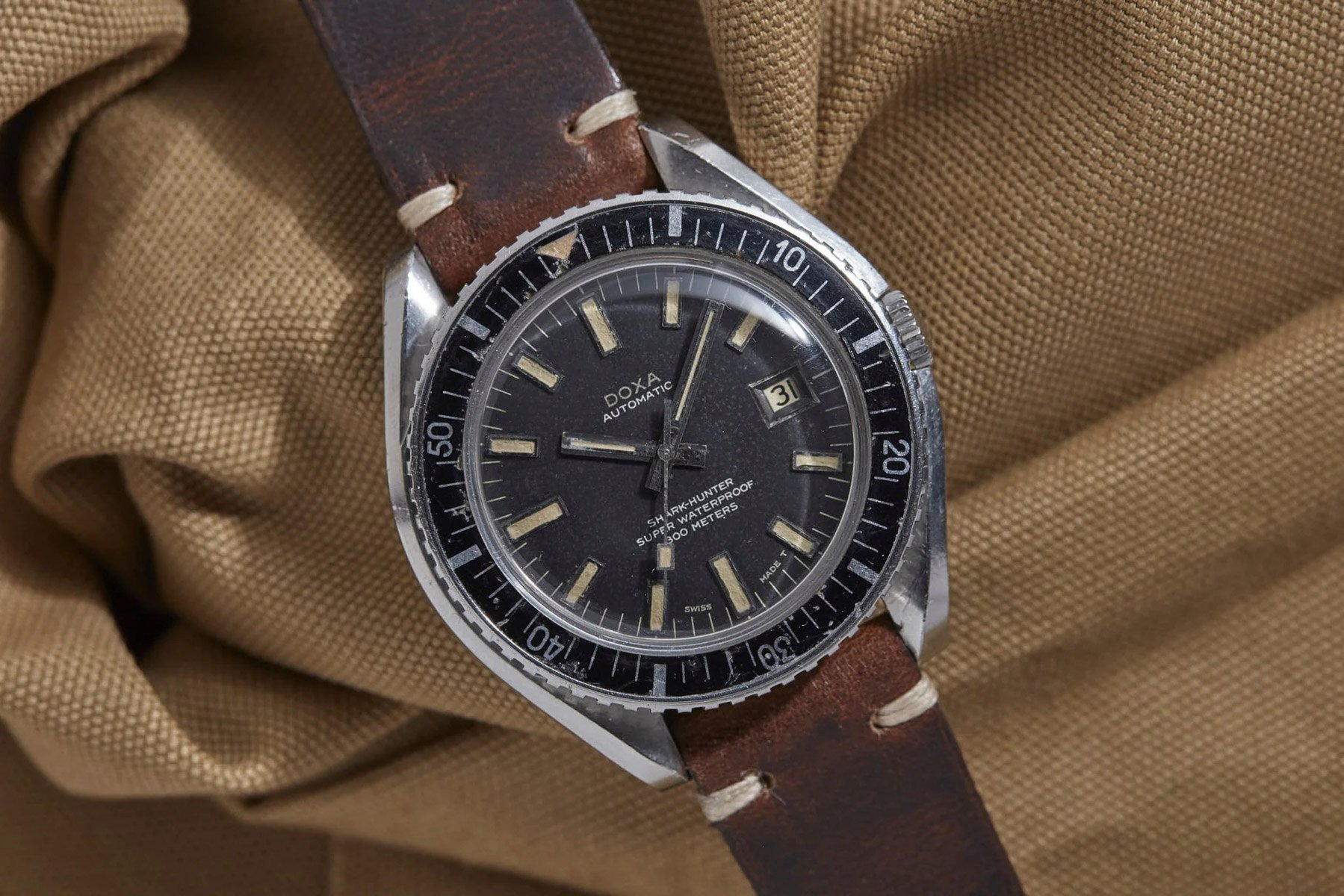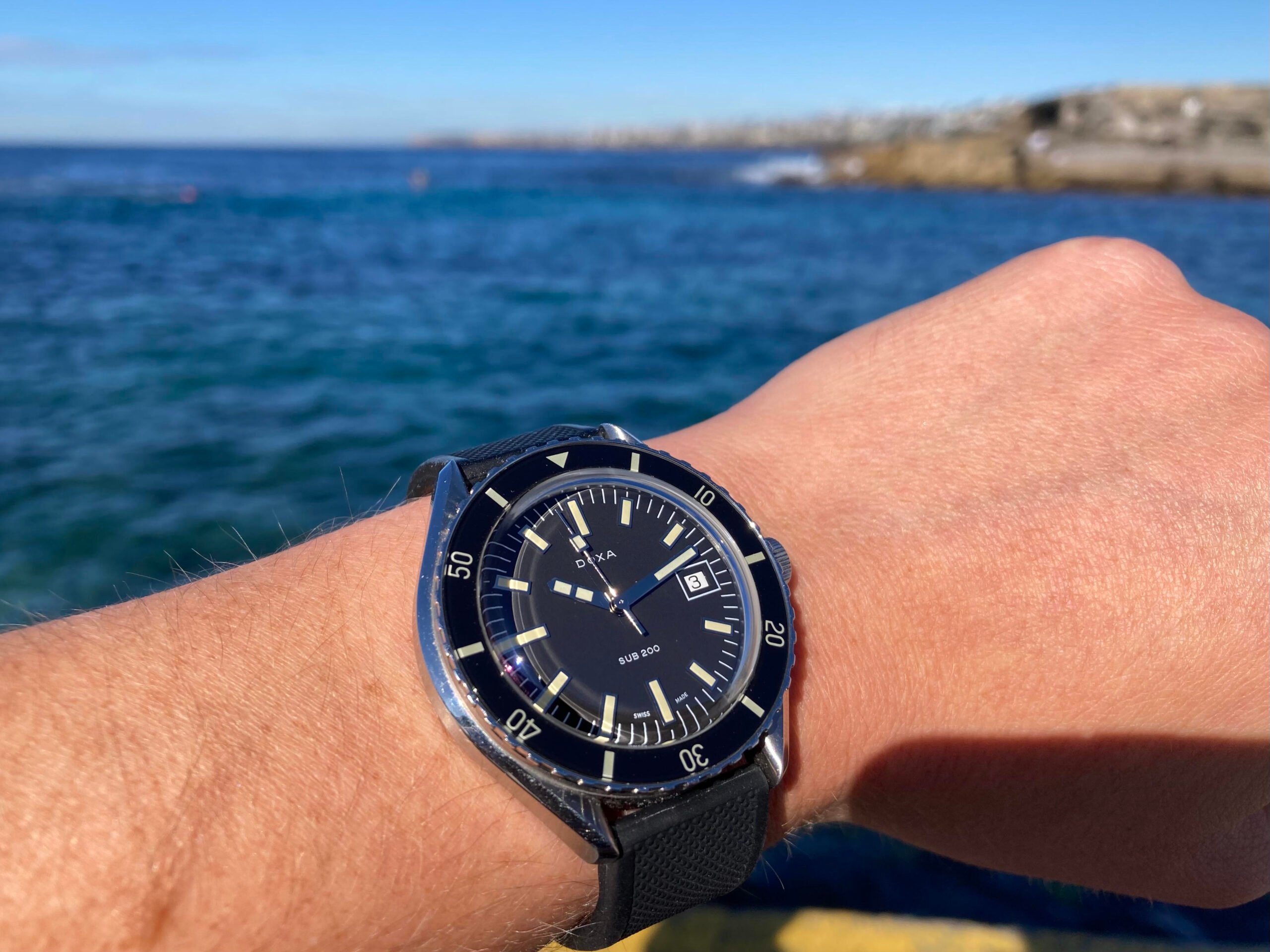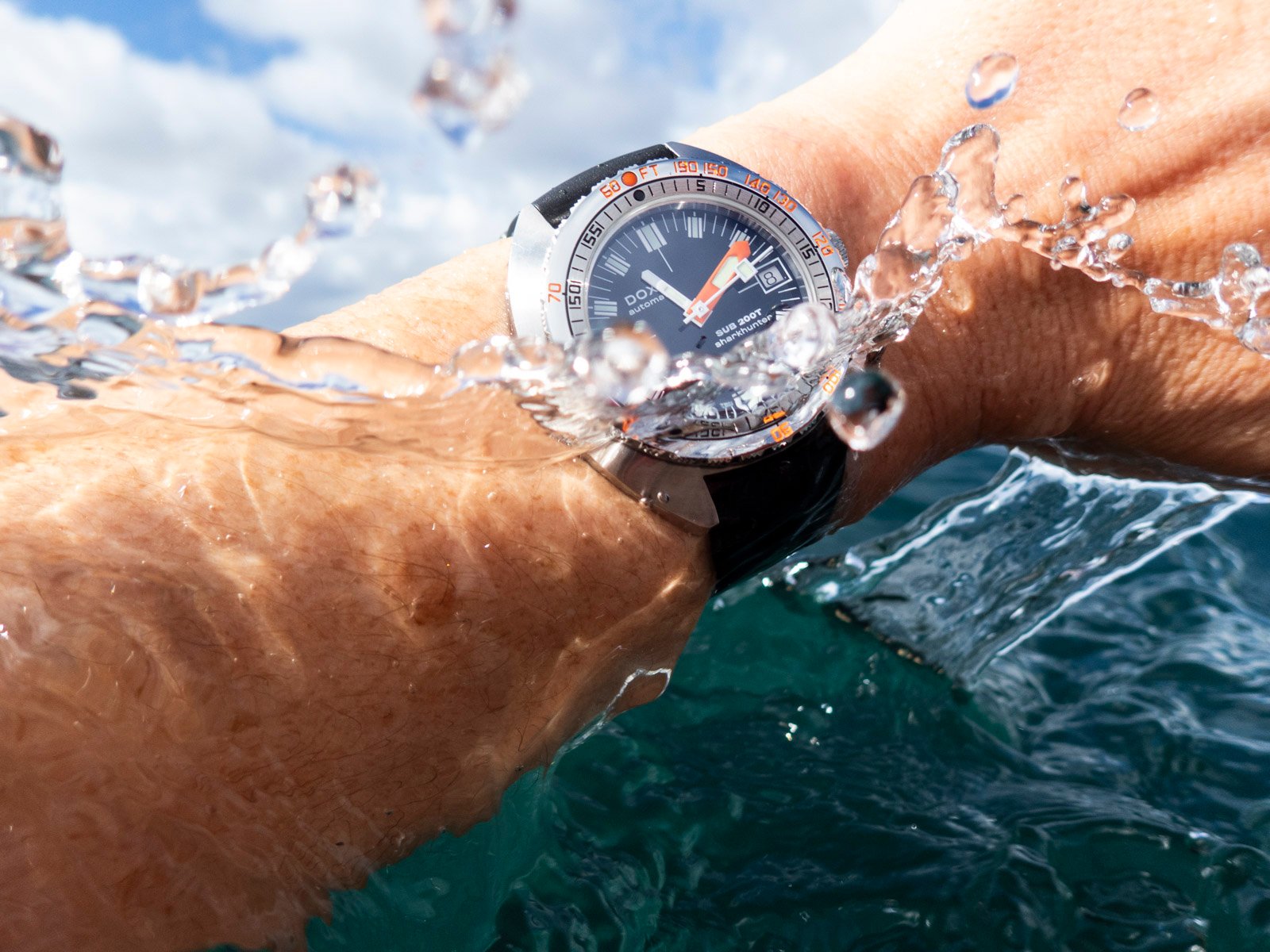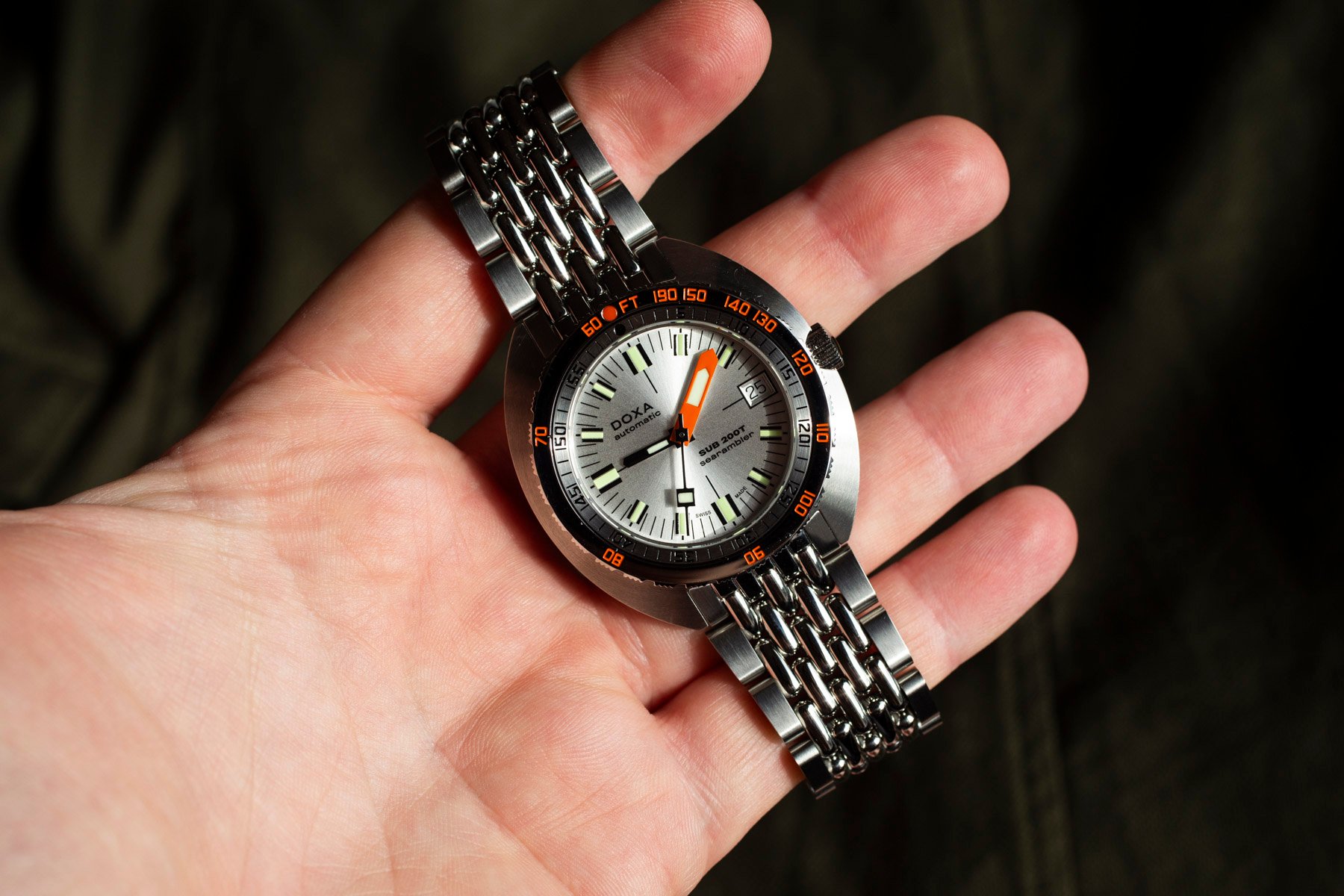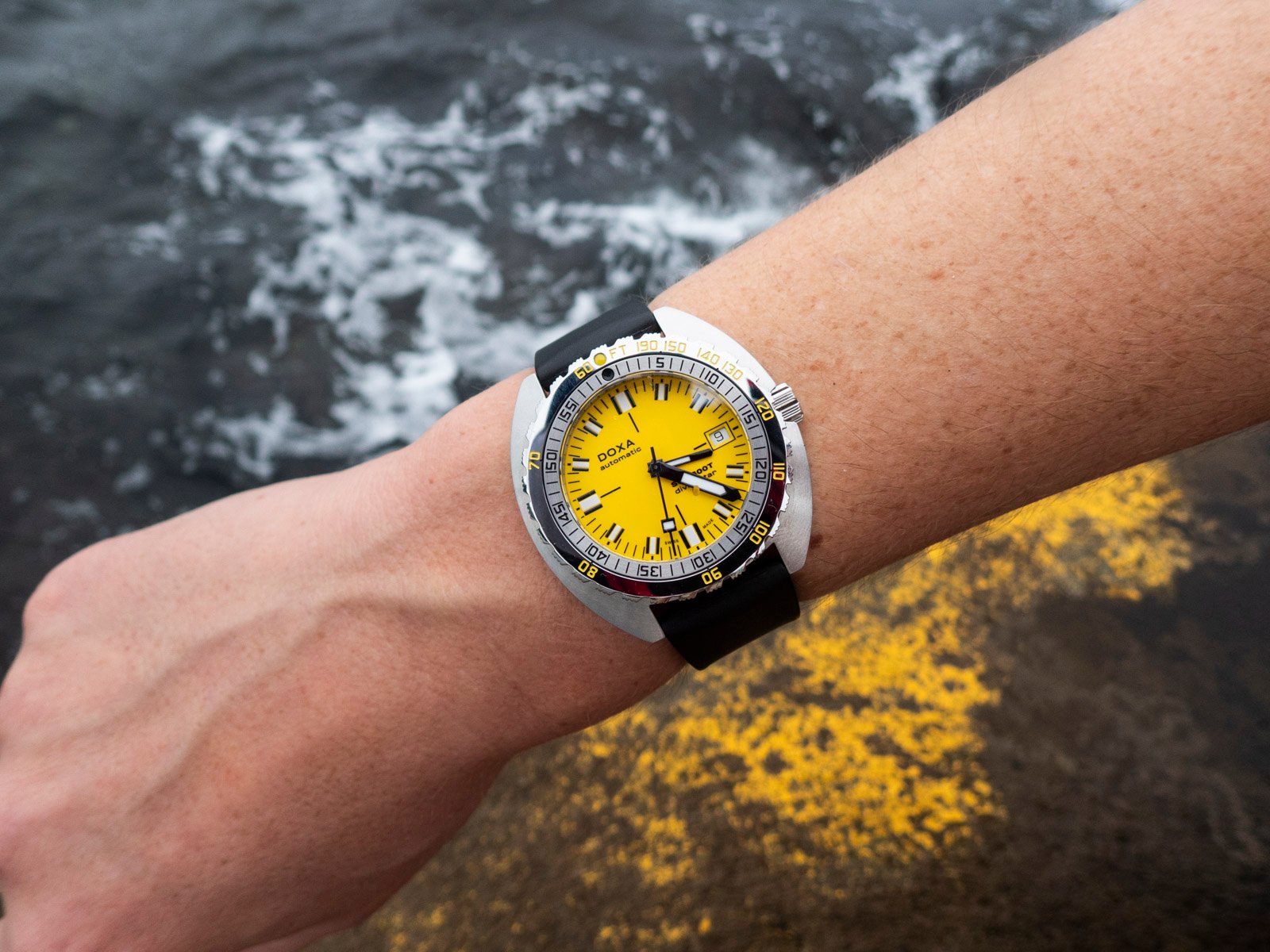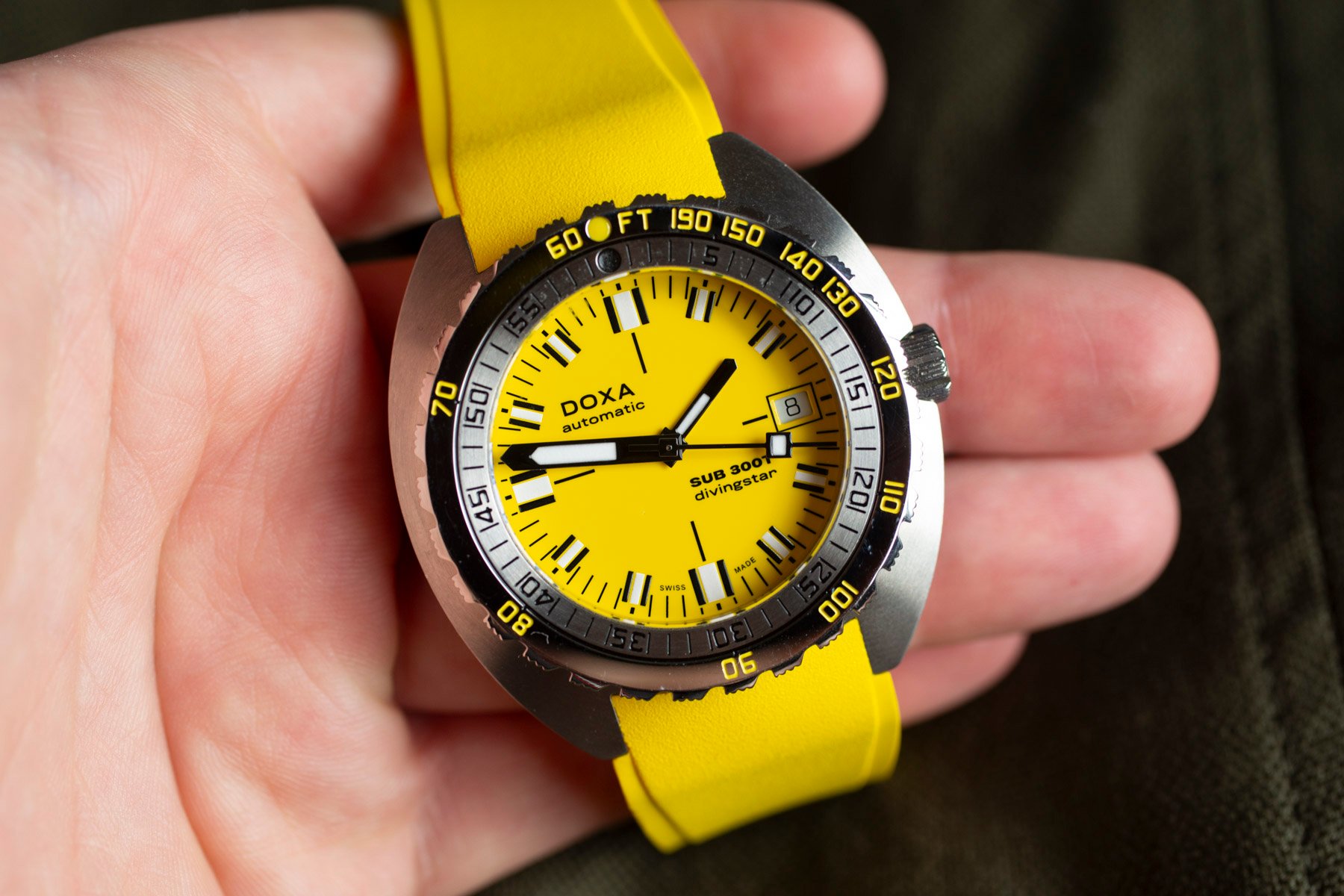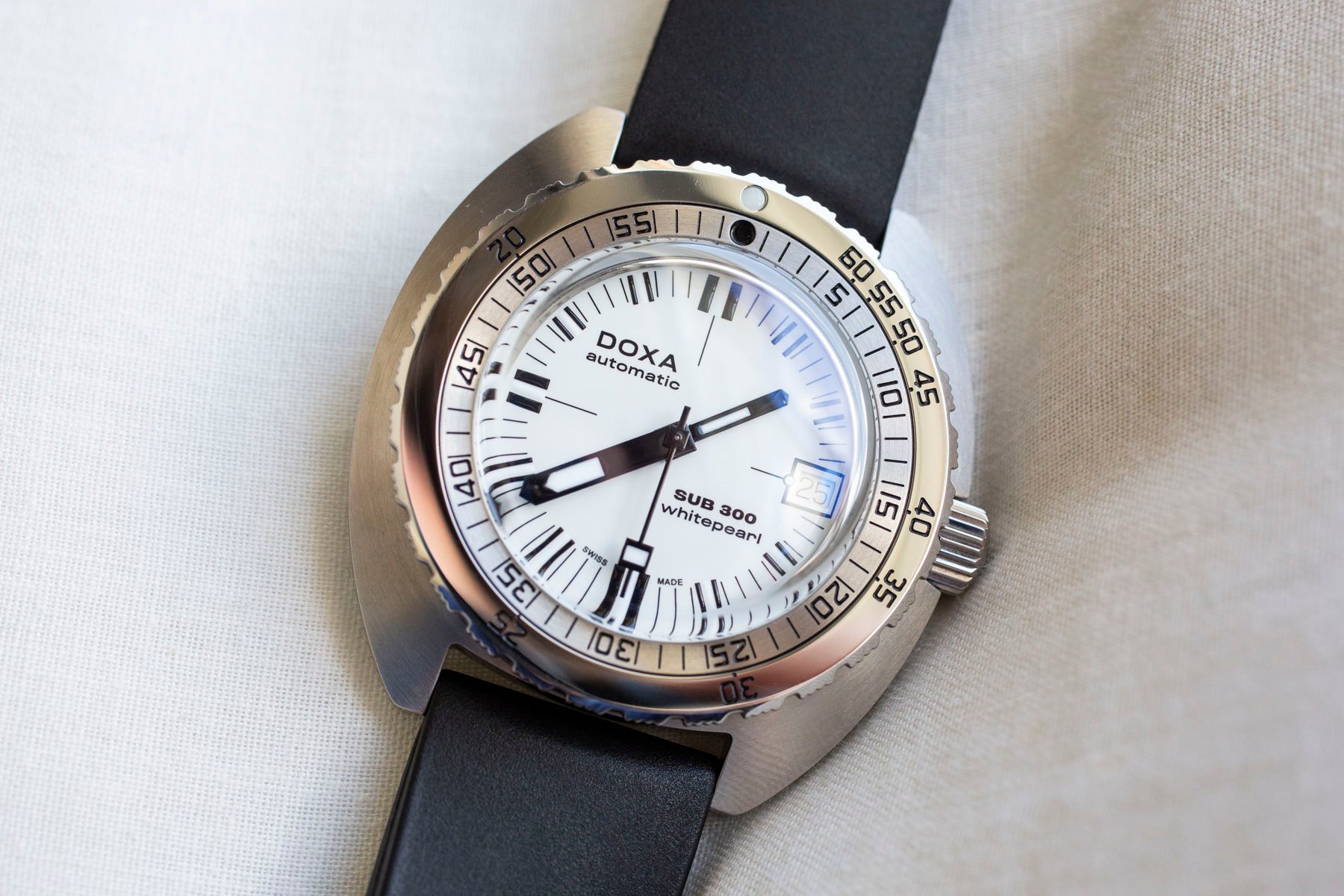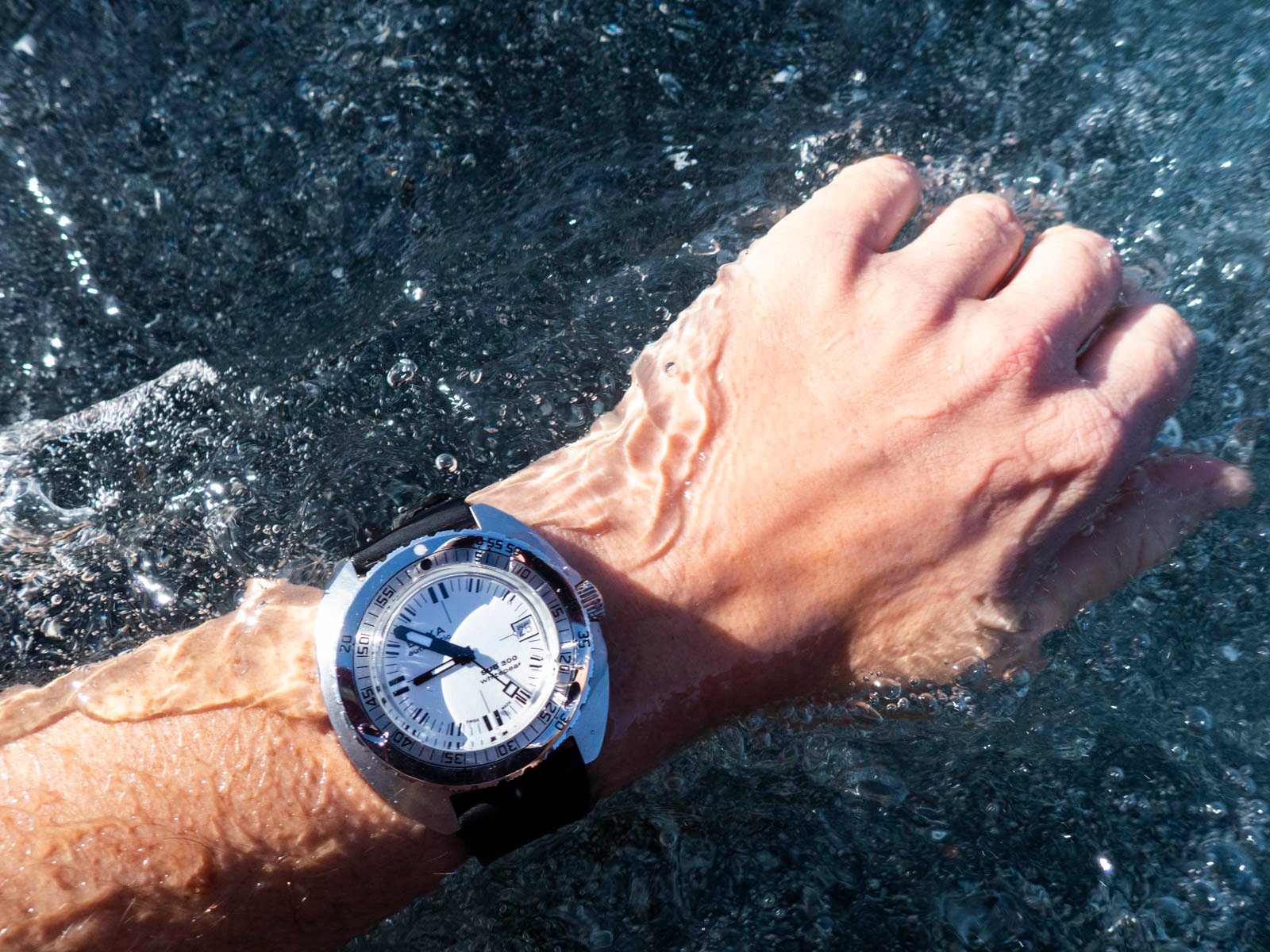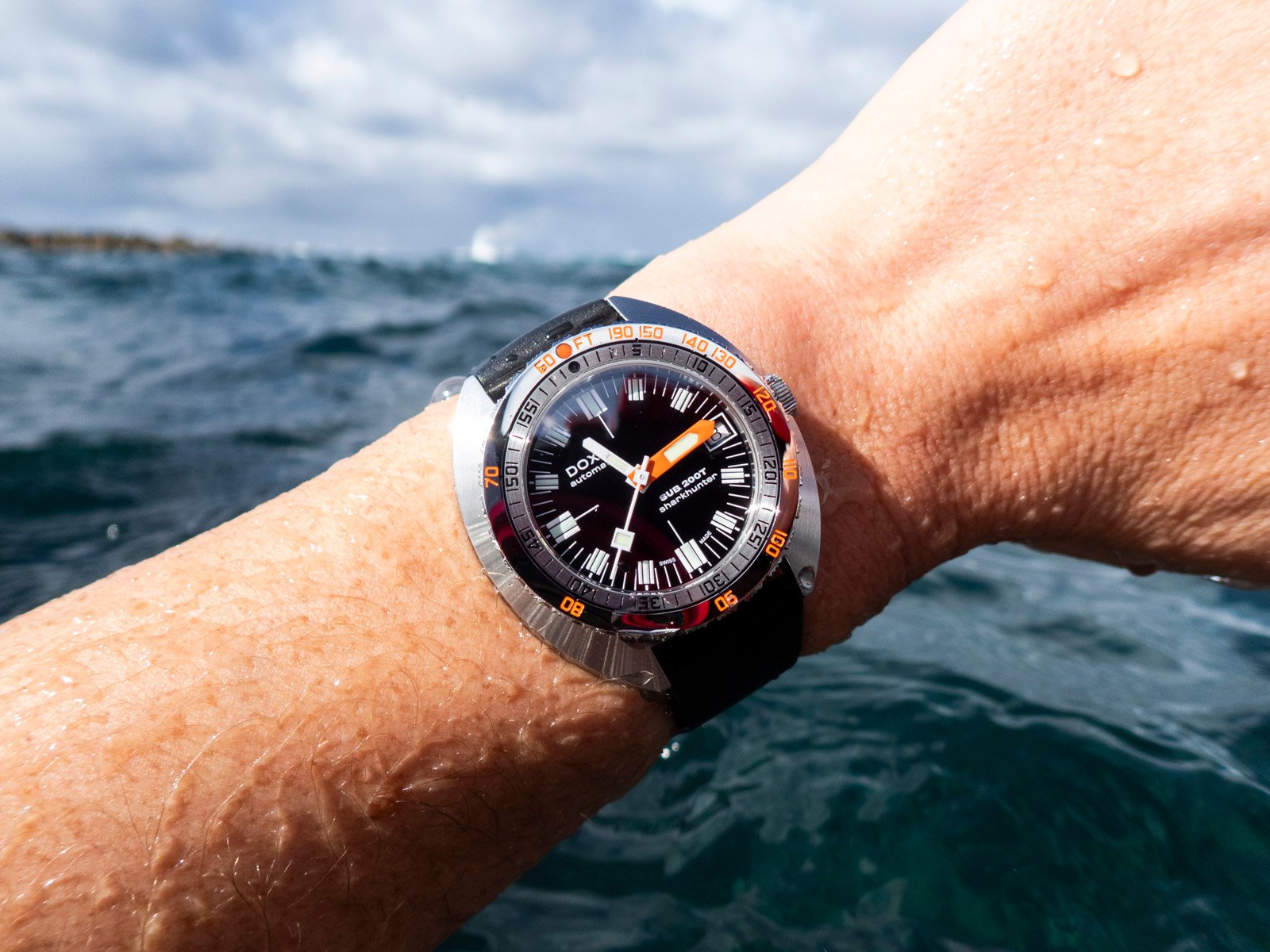Which Doxa Sub Is Right For You?
It’s no surprise that I am a fan of the Doxa Sub line of watches. My first new Swiss-made watch was a Doxa, though it was not one of the iconic cushion-cased designs. Today, I’ll go through four of Doxa’s key dive-watch offerings and hopefully help you determine which one is right for you.
When looking through Doxa’s catalog with a friend who is new to watches the other day, I noticed how confused he got. It’s understandable because Doxa’s naming conventions don’t always make sense. Why, for example, is the 1,200m-rated dive watch called the 300T? So, for the sake of clarity, I am going to briefly run through four of the brand’s most popular watches and the merits of each. One thing worth noting is that, unlike many other brands, there is little difference between these four watches in the movement department. All of them will house either an ETA 2824-2 or Sellita SW200-1. The only significant difference is that the top-of-the-line Sub 300 comes with a COSC-certified movement, meaning it will run within -4 to +6 seconds a day.
Doxa Sub ancestors
My first new Swiss-made watch was a Doxa Sub 200. But while many of our readers are familiar with some of the history of Doxa’s cushion-cased designs, some may be unfamiliar with the very first dive watch the brand introduced, which is what inspired the Sub 200 of today.
You see, as I have noted before, back in the mid-1960s, Doxa wanted to make a dive watch to compete with other brands that already produced watches for the sport. At the time, diving was growing in popularity. Rolex already had the Submariner, Blancpain had the Fifty Fathoms, and Zodiac had the Sea Wolf. Between the early 1950s when those watches debuted and the mid-’60s, many other options had become available too.
A watch for the times
Before releasing the Sub 300, Doxa experimented with a dive-watch design. This watch was the “Shark-Hunter” ref. 11804, and the belief is that it came out in 1963, four years before the Sub 300. The Doxa 11804 had much in common with the Eberhard Scafograf and also shared some resemblance to the Omega Seamaster 300 of the time. This was because it shared a similar case design with beautiful lyre lugs. The theory is that all three watches shared the same case.
The 11804 had a 300m water resistance rating despite having a push-pull crown. The modern Doxa Sub 200 is based on this 1963 design. But although Doxa had its conventional dive watch, the brand had bold ambitions to make a dedicated tool that included a no-decompression scale on the bezel. Fast-forward to 1967, and Doxa introduced the Sub 300, which would become the brand’s icon.
Doxa Sub 200 — The entry-level king
This brings me to the first watch we will look at today, Doxa’s entry-level Sub 200 (no T). This watch, as I noted further up, is based on Doxa’s first foray into the world of dive watches. It is a far more standard design with an elapsed-time bezel and a relatively sparse dial with applied markers except for the date at 3 o’clock. Doxa nailed some key details here, including the simple two lines of text denoting the model and brand names. The other thing the brand got “right” was the typeface, even down to the numerals on the date disc.
The Doxa Sub 200 was a pre-COVID release, and I think this shows. The heavy use of faux patina and the lack of one-minute markers on the bezel meant that I eventually got tired of this design and sold the watch. But with a 42mm case that feels like 40mm thanks to a short 46mm lug-to-lug, this Doxa Sub 200 wears very well. The 200m depth rating is plenty, and while the 13.8mm thickness is significant, much of that is due to the domed sapphire crystal. The lugs do have an annoying (though very vintage-like) 19mm spacing. All in all, though, at €1,150 on a bracelet, the Doxa Sub 200 is a great entry-level Swiss dive watch, even if it has a few less desirable attributes. But, because of some of the design choices, my recommendation goes to our next candidate.
Doxa Sub 200T — The mid-sized newcomer
Doxa’s new Sub 200T is an attractive proposition. It shares many of the fundamental specifications of the Sub 200 above. This includes a solid 200m water resistance rating, a screw-down crown, a screw-in case back, and a Swiss automatic ETA 2824-2 or equivalent Sellita caliber. For only a slight bump in price, you also find yourself buying your way into the iconic cushion-cased design that made the original Doxa Sub 300 famous upon its release in 1967.
The cushion shape means this 39mm watch has just a 41.5mm lug-to-lug! This makes it wear quite small. For comparison, I find it feels and looks slightly smaller on the wrist than the Tudor Black Bay 54, which is a 37mm dive watch. At 10.7mm thick, the Sub 200T is also refreshingly slim.
Sized to perfection…almost
Besides the iconic cushion-cased design, shrunken hour hand, and no-deco bezel, the Doxa Sub 200T also provides an array of dial colors. Yes, the Doxa Sub 200 also provides colors, but the 200Ts come with more white-lume options! I’m currently eying the Doxa Sub 200T in Divingstar yellow with a degree of lust.
The Sub 200T is a perfect Doxa watch for those of us after a mid-sized option. It’s my number-one pick on the bracelet. The 18mm lug spacing is a common size (for dress watches), even if it’s a bit small for my tastes. I’d prefer a 20mm lug opening with this case. Regardless, at €1,590 on a bracelet, this is the option I would go for.
Doxa Sub 300T — The bold brute
For those of us who like the rugged charm of a Sinn dive watch, a burly chronograph, or perhaps an oversized Seiko, there will be much to find appealing about the Doxa Sub 300T. This is the value-rich offering in the Doxa Sub stable. Providing a whopping 1,200m depth rating, a helium escape valve, and flat sapphire crystal, the 300T is a very modern watch. The original 300T was known as the Conquistador, and it was a cutting-edge dive watch in the late 1960s.
The Doxa Sub 300T has a 42.5mm case with a short 44.5mm lug-to-lug and a 13.65mm profile. The bezel comprises a significant portion of that last measurement, making this watch look and feel quite thick on the wrist.
How to think of the Sub 300T
This is the grippiest bezel I have ever interacted with. If the Sub 300 is Doxa’s answer to the Rolex Submariner or Omega Seamaster, this Sub 300T is the Sea-Dweller or Planet Ocean equivalent. You will also find that the Doxa Sub 300T feels chunkier than the 13.65mm measurement would suggest. I attribute this to the heft and weight of the watch.
It must be the seals or something, but it does feel a lot chunkier than any of the other Doxas on our list today. This provides a level of assuredness. Like the Doxa Sub 300 I am about to talk about, the Doxa Sub 300T offers a 20mm lug spacing, making it highly adaptable to different strap combinations. Inside ticks a Sellita SW200-1 or ETA 2824-2. At €1,990 on a beads-of-rice bracelet, the 300T gives you a lot of great specs for the money if you like a beefy watch.
Doxa Sub 300 — The classic
For some of us, only the original (re-edition) will do. The Sub 300 is the Doxa. The current Sub 300 is a faithful re-edition of the original from 1967 (bar some changes to specifications and dial font). The Doxa Sub 300 debuted in 1967 and presented the unique design ethos that shaped the brand to the modern day.
From the tiny hour hand to the no-deco bezel and the offset text, everything we associate with Doxa dive watches started with the Sub 300. It’s also the only watch in this article to house a COSC-certified SW200-1 or ETA 2824-2 caliber.
Doxa, if you’re listening…
This watch has a 42.5mm case diameter and a 45mm lug-to-lug, making it equal in width but slightly longer than the 300T. Thickness-wise, this model measures 13.4mm, but it feels considerably slimmer than the 300T because the domed sapphire glass makes up much of that. And it’s here where I have my first gripe with this watch. The sapphire crystal is so domed that it affects reading the time with this watch underwater. I’ve compared it to a 1960s original, which was less domed, so it’s something I’d like to see Doxa change in a manufacturing update.
As mentioned in the section on the 300T, the Sub 300 has a 20mm lug spacing, so strap choices will be a cinch. The lume, though, is my next issue with this watch. Doxa, if you’re reading this, beef up the lume application on this watch, please! At €2,790 on a bracelet, this is the most expensive watch here, but that is a reasonable price of entry for an iconic with a history as rich as the Rolex Submariner or Omega Seamaster 300.
Concluding thoughts
To conclude, I think that anyone passionate about dive watches or even tool watches in general should look into Doxa. The good thing is, with so many colorways, sizes, and price points, there are plenty of options for everyone. As I said earlier in this story, I am leaning toward a yellow Doxa Sub 200T on the bracelet.
But what do you think, Fratelli? If you were to buy one, what Doxa Sub (including color) would you get? And why? I look forward to reading your choices in the comments.

